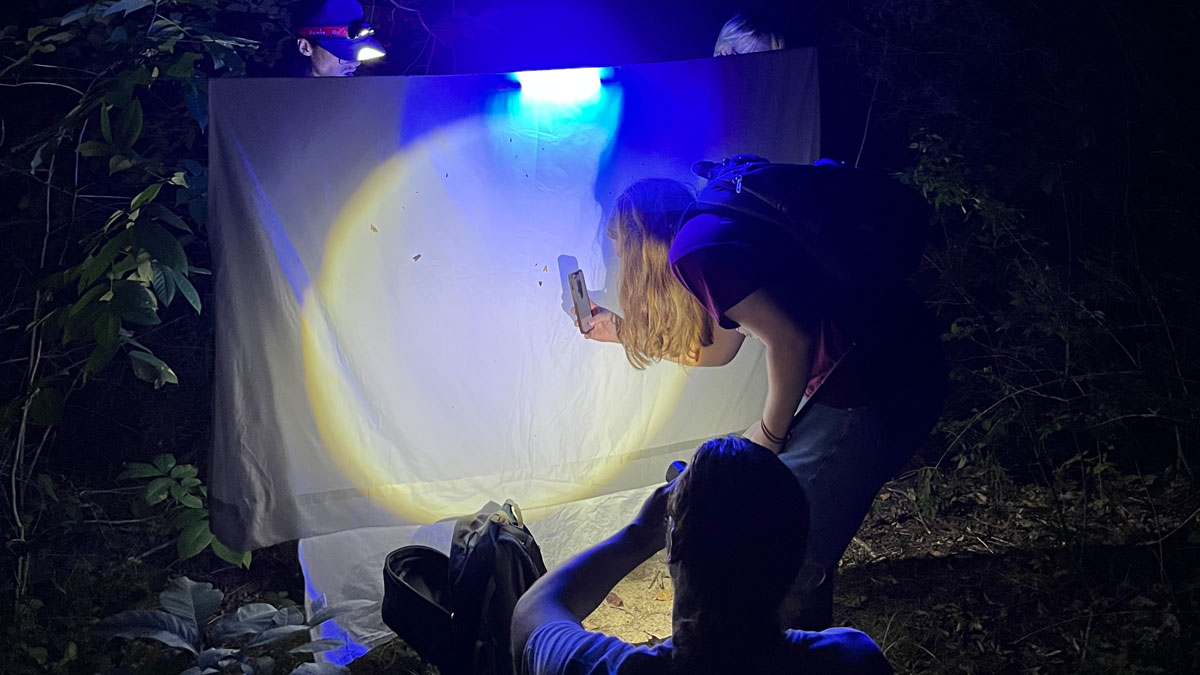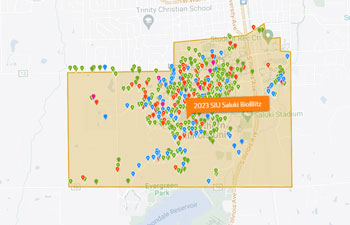
Top: Volunteers observe and identify various species of insects during the 2023 Saluki BioBlitz, held Sept. 1 on campus. Below: An interactive map from the latest Saluki BioBlitz shows where various organisms were encountered. Green dots are plants; red are insects, mollusks or arachnids; blue are ray-finned fishes, birds, amphibians, reptiles, mammals or other animals; pink are fungi; brownish red is kelp, diatoms or allies; purple are protozoans and gray are unknown, prokaryotes, bacteria or viruses. (Images provided)
November 02, 2023
BioBlitz citizen scientists record 435 species on SIU campus
CARBONDALE, Ill. – Citizen scientists documented more species than ever during the latest Saluki BioBlitz, an annual survey of flora and fauna on the campus of Southern Illinois University Carbondale.
Participants documented 435 unique species in a 24-hour window on Sept. 1. The latest event brought the three-year total to more than 4,000 observations of 675 unique species, said Brent Pease, assistant professor of wildlife in the School of Forestry and Horticulture, who organized the effort.
“This was an exciting year for the Saluki BioBlitz,” Pease said. “My goal has always been to hit 1,000 species on campus, and I hope we can keep moving toward that.”
Saluki BioBlitz is a concentrated effort to record as many species as possible within a designated location and time period, which can vary from a single day to an entire month. The designated location can be anywhere but is usually a clearly defined place such as a park or, as in this case, a university campus.
The event is a “citizen science” effort, which involves the general public of all ages, as well as SIU students, staff and faculty, in the scientific process. Participants record their observations via a smartphone app connected to an online platform called iNaturalist. The online community then works together to identify all the observations to the highest taxonomic resolution possible.
 More than 500 students, faculty, staff and members of the general public have participated in the Saluki BioBlitz since its inaugural event in September 2021.
More than 500 students, faculty, staff and members of the general public have participated in the Saluki BioBlitz since its inaugural event in September 2021.
As habitats change and plants and animals face evolving pressures, Pease said, regularly taking stock of the natural inventory is particularly important. BioBlitz gives a community and researchers a wildlife snapshot. Once researchers collect several years of data, they can start to build a better picture to understand where and how species composition is changing across time and space.
“My big hope is just to continue to keep building awareness of the project and let the university and community know that anyone can participate,” Pease said. “It is easy, and you need no specific knowledge, just an interest and curiosity in nature.”
The Saluki BioBlitz results will remain online in open-access biodiversity databases, Pease said. This allows researchers, wildlife managers, practitioners and the general public to use the information to understand when and where a given species occurred in history.
